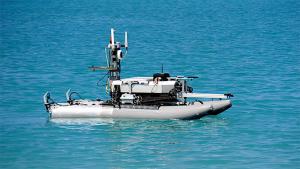VNR: UH experts develop new tech to find sea-disposed munitions
University of Hawaiʻi at MānoaLink to video and sound: https://go.hawaii.edu/LKa
Over the past 15 years the University of Hawaiʻi's Applied Research Laboratory (ARL at UH) has worked to locate and map thousands of munitions (bombs, bullets, etc.) the U.S. military disposed off of the coast of Hawaiʻi after World War II. Since the mid 1940s, the munitions have been corroding on the ocean floor, often in shallow waters, where they potentially pose a risk to beachgoers, swimmers, surfers and divers.
"Around the end of World War II, there were a lot of excess, obsolete and damaged bombs here in Hawaiʻi,” said Margo Edwards, director of ARL at UH, who has been spearheading the effort. “And the way we disposed of them was dumping them in the ocean. So we’re trying to find the things that were dumped in the ocean decades ago.”
Researchers estimate that Hawaiʻi’s sea floor is littered with more than 100,000 underwater munitions, with some being discovered near popular recreational areas such as Kāneʻohe Bay and Lanikai Beach. ARL at UH is developing new technologies designed to detect munitions using advanced ocean platforms and sensor payloads. They tested their approach over the summer from an uncrewed surface vessel at Sand Island.
“We have some ocean sensors that are connected with our Mini Sondes or MiSos that are collecting ocean temperature, ocean pressure, sound speed and supply voltage,” said Joshua Baghdady, a research engineer at ARL at UH. “They're feeding back to our ground station in near real-time.”
The project brings together both UH and high school students, providing hands-on training in the latest underwater detection technologies. By emphasizing workforce development, the project aims to equip the next generation with skills in underwater mapping while fostering an interest in STEM career pathways.
“We want to create maps of the area around Oʻahu so we can tell people where there might be a hazard, so that's one thing,” said Edwards. “But the second part that you'll see looking at this team is we're training the next generation of people to be able to do this work.”
Common practice globally
The issue of sea-disposed munitions is not a problem unique to Hawaiʻi, as the practice was common across the global ocean, and the exact locations of many dump sites were poorly documented. At the time the munitions were disposed, navigation systems such as GPS, the Global Positioning System, were neither prevalent nor very accurate, creating an ongoing challenge for those attempting to find munitions and assess or remediate them.
“I was in Malta, right in the middle of the Mediterranean, talking to the folks there who are dealing with the same problem to tell them about the techniques that we're trying to develop in Hawaiʻi,” said Edwards. “So that they can potentially put them to good use too.”
The Department of Defense approved a two-year partnership with UH to establish a Maritime Test Range Complex. This project will enable researchers from around the world to test new detection technologies in Hawaiʻi’s clear waters.
Recognize, retreat, report
A key component of the ARL at UH’s work is furthering public education and public awareness of safety procedures related to munitions. The Army's 3Rs Program aims to inform the public about what they should do if they suspect they have encountered munitions:
- Recognize: Be aware when you may have encountered munitions, and that munitions are dangerous.
- Retreat: Do not approach, touch, move or disturb munitions, but carefully leave the area.
- Report: Call 911 and advise the police of what you saw and where you saw it.
B-ROLL: trt 2:02
SOUNDBITES:
Margo Edwards, UH Applied Research Lab director (:16)
“Around the end of World War II there were a lot of excess, obsolete and damaged bombs here in Hawaiʻi. And the way that we disposed of them was dumping in the ocean. So we're trying to find the things that were dumped in the ocean decades ago.”
Edwards (:16)
“We want to create maps of the area around Oʻahu so we can tell people where there might be a hazard. So that's one thing. But two is what you'll see looking at this team is we're training the next generation of people to be able to do this work.”
Joshua Baghdady, UH Applied Research Lab research engineer (:13)
“We have some ocean sensors that are connected with our Mini Sondes or MiSos those are collecting ocean temperature, ocean pressure, sound speed and supply voltage. They're feeding back to our ground station in near real time.”
###

